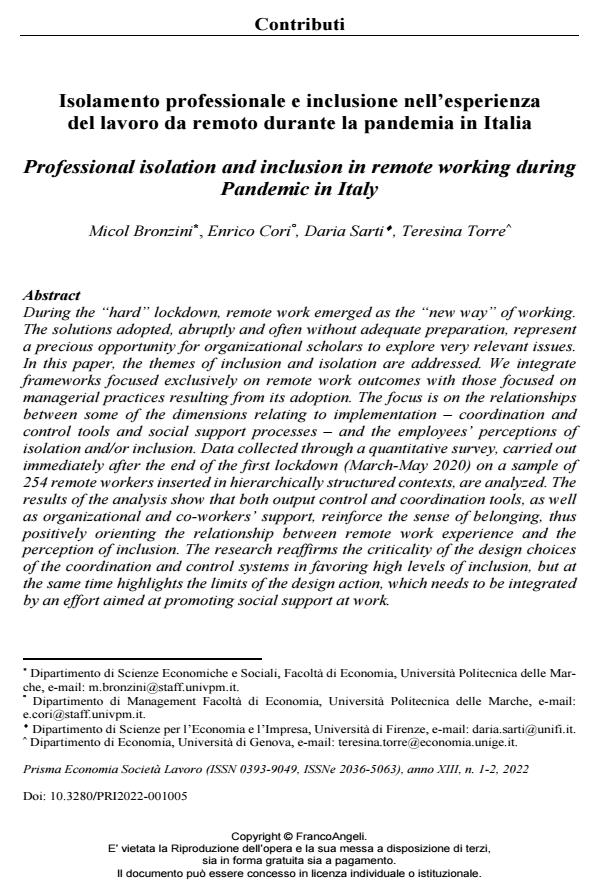Professional isolation and inclusion in remote working during Pandemic in Italy
Journal title PRISMA Economia - Società - Lavoro
Author/s Micol Bronzini, Enrico Cori, Daria Sarti, Teresina Torre
Publishing Year 2023 Issue 2022/1-2
Language Italian Pages 22 P. 68-89 File size 344 KB
DOI 10.3280/PRI2022-001005
DOI is like a bar code for intellectual property: to have more infomation
click here
Below, you can see the article first page
If you want to buy this article in PDF format, you can do it, following the instructions to buy download credits

FrancoAngeli is member of Publishers International Linking Association, Inc (PILA), a not-for-profit association which run the CrossRef service enabling links to and from online scholarly content.
During the “hard” lockdown, remote work emerged as the “new way” of working. The solutions adopted, abruptly and often without adequate preparation, represent a precious opportunity for organizational scholars to explore very relevant issues. In this paper, the themes of inclusion and isolation are addressed. We integrate frameworks focused exclusively on remote work outcomes with those focused on managerial practices resulting from its adoption. The focus is on the relationships between some of the dimensions relating to implementation – coordination and control tools and social support processes – and the employees’ perceptions of isolation and/or inclusion. Data collected through a quantitative survey, carried out immediately after the end of the first lockdown (March-May 2020) on a sample of 254 remote workers inserted in hierarchically structured contexts, are analyzed. The results of the analysis show that both output control and coordination tools, as well as organizational and co-workers’ support, reinforce the sense of belonging, thus positively orienting the relationship between remote work experience and the perception of inclusion. The research reaffirms the criticality of the design choices of the coordination and control systems in favoring high levels of inclusion, but at the same time highlights the limits of the design action, which needs to be integrated by an effort aimed at promoting social support at work.
Keywords: Remote work, Professional isolation, Inclusion, Coordination and control, Social support, COVID-19 pandemic
- Fostering quality and well-being: remote work strategies in italian SMEs Marino Pezzolo, Ugo Ascoli, in STUDI ORGANIZZATIVI 2/2025 pp.59
DOI: 10.3280/SO2025-002003 - Augmenting Human Resource Management with Artificial Intelligence Aizhan Tursunbayeva, pp.63 (ISBN:978-3-031-75265-0)
Micol Bronzini, Enrico Cori, Daria Sarti, Teresina Torre, Isolamento professionale e inclusione nell’esperienza del lavoro da remoto durante la pandemia in Italia in "PRISMA Economia - Società - Lavoro" 1-2/2022, pp 68-89, DOI: 10.3280/PRI2022-001005